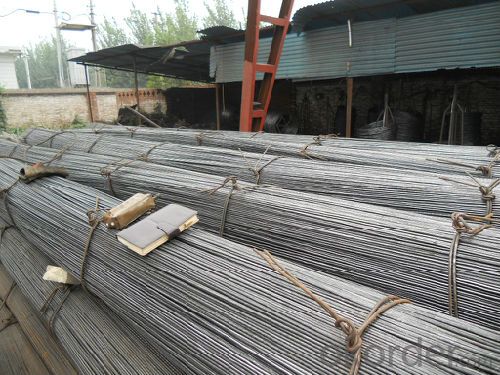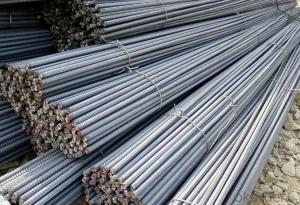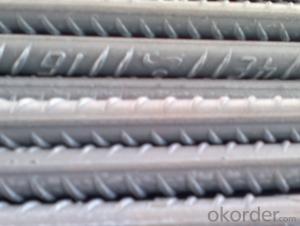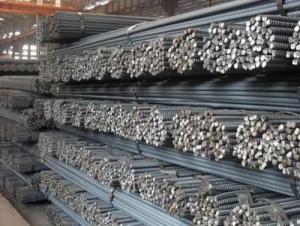Hot Rolled Steel HRB500 Deformed steel bar for Construction
- Loading Port:
- Tianjin
- Payment Terms:
- TT or LC
- Min Order Qty:
- 1000 m.t.
- Supply Capability:
- 10000 m.t./month
OKorder Service Pledge
OKorder Financial Service
You Might Also Like
Product Description:
OKorder is offering Hot Rolled Steel HRB500 Deformed steel bar for Construction at great prices with worldwide shipping. Our supplier is a world-class manufacturer of steel, with our products utilized the world over. OKorder annually supplies products to European, North American and Asian markets. We provide quotations within 24 hours of receiving an inquiry and guarantee competitive prices.
Product Applications:
Hot Rolled Steel HRB500 Deformed steel bar for Construction are ideal for structural applications and are widely used in the construction of buildings and bridges, and the manufacturing, petrochemical, and transportation industries.
Product Advantages:
OKorder's Hot Rolled Steel HRB500 Deformed steel bar for Construction are durable, strong, and resist corrosion.
Main Product Features:
· Premium quality
· Prompt delivery & seaworthy packing (30 days after receiving deposit)
· Corrosion resistance
· Can be recycled and reused
· Mill test certification
· Professional Service
· Competitive pricing
Product Specifications:
Standard | GB | HRB400 | |
Diameter | 6mm,8mm,10mm,12mm,14mm,16mm,18mm,20mm, 22mm,25mm,28mm,32mm,36mm,40mm,50mm | ||
Length | 6M, 9M,12M or as required | ||
Place of origin | Hebei, China mainland | ||
Advantages | exact size, regular package, chemical and mechanical properties are stable. | ||
Type | Hot rolled deformed steel bar | ||
Brand name | DRAGON | ||
Grade | Technical data of the original chemical composition (%) | ||||||
C | Mn | Si | S | P | V | ||
HRB400 | ≤0.25 | ≤1.60 | ≤0.80 | ≤0.045 | ≤0.045 | 0.04-0.12 | |
Physical capability | |||||||
Yield Strength (N/cm²) | Tensile Strength (N/cm²) | Elongation (%) | |||||
≥400 | ≥570 | ≥14 | |||||
Packaging & Delivery of Hot Rolled d-bar Steel
1. Packing: it is nude packed in bundles by steel wire rod
2. Bundle weight: not more than 3.5MT for bulk vessel; less than 3 MT for container load
3. Marks:
Color marking: There will be color marking on both end of the bundle for the cargo delivered by bulk vessel. That makes it easily to distinguish at the destination port.
Tag mark: there will be tag mark tied up on the bundles. The information usually including supplier logo and name, product name, made in China, shipping marks and other information request by the customer.
If loading by container the marking is not needed, but we will prepare it as customer request.
4. Transportation: the goods are delivered by truck from mill to loading port, the maximum quantity can be loaded is around 40MTs by each truck. If the order quantity cannot reach the full truck loaded, the transportation cost per ton will be little higher than full load.
5. Delivered by container or bulk vessel
FAQ:
Q1: Why buy Materials & Equipment from OKorder.com?
A1: All products offered byOKorder.com are carefully selected from China's most reliable manufacturing enterprises. Through its ISO certifications, OKorder.com adheres to the highest standards and a commitment to supply chain safety and customer satisfaction.
Q2: How do we guarantee the quality of our products?
A2: We have established an advanced quality management system which conducts strict quality tests at every step, from raw materials to the final product. At the same time, we provide extensive follow-up service assurances as required.
Q3: How soon can we receive the product after purchase?
A3: Within three days of placing an order, we will begin production. The specific shipping date is dependent upon international and government factors, but is typically 7 to 10 workdays.
Q4: What makes stainless steel stainless?
A4: Stainless steel must contain at least 10.5 % chromium. It is this element that reacts with the oxygen in the air to form a complex chrome-oxide surface layer that is invisible but strong enough to prevent further oxygen from "staining" (rusting) the surface. Higher levels of chromium and the addition of other alloying elements such as nickel and molybdenum enhance this surface layer and improve the corrosion resistance of the stainless material.
Q5: Can stainless steel rust?
A5: Stainless does not "rust" as you think of regular steel rusting with a red oxide on the surface that flakes off. If you see red rust it is probably due to some iron particles that have contaminated the surface of the stainless steel and it is these iron particles that are rusting. Look at the source of the rusting and see if you can remove it from the surface.
Images:



- Q:What is the purpose of ribbing on a steel rebar?
- The purpose of ribbing on a steel rebar is to improve the bond between the rebar and the surrounding concrete. Raised deformations, known as ribs, run along the length of the rebar, creating a larger surface area for the concrete to grip onto. This larger surface area enhances the mechanical interlock between the rebar and concrete, resulting in better load transfer and improved structural integrity. Additionally, the ribbing prevents slippage or movement of the rebar within the concrete, ensuring that the reinforcement remains in its intended position, even under heavy loads or seismic activity. In summary, the ribbing on a steel rebar is vital for enhancing the performance and durability of reinforced concrete structures.
- Q:What is the standard length of steel rebars?
- The standard length of steel rebars typically ranges from 6 meters to 12 meters, depending on the specific requirements and regulations of the construction industry in different countries.
- Q:What are the design considerations for using steel rebars in construction?
- Some important design considerations for using steel rebars in construction include the required strength and load-bearing capacity, corrosion resistance, compatibility with other construction materials, durability, and ease of installation. Steel rebars should be chosen based on their appropriate diameter, grade, and spacing to ensure structural integrity and safety. Additionally, proper detailing and placement of rebars are essential to ensure that they are effectively embedded within concrete and can withstand the anticipated stresses and forces during construction and throughout the lifespan of the structure.
- Q:What is the effect of carbonation on steel rebars?
- The effect of carbonation on steel rebars is corrosion. Carbonation reduces the alkalinity of concrete, which leads to the breakdown of the passive layer on the steel surface. This allows moisture and oxygen to reach the steel, causing it to corrode and potentially weaken the structure over time.
- Q:Can steel rebars be used in sports arena construction?
- Yes, steel rebars can be used in sports arena construction. Steel rebars are commonly used as reinforcement in concrete structures, including sports arenas. The use of steel rebars provides added strength and stability to the concrete, ensuring that the structure can withstand the loads and stresses imposed by the arena's design, such as the weight of the roof, seating, and equipment. Additionally, steel rebars help to prevent cracking and improve the overall durability of the arena. They are often embedded within the concrete foundation, columns, and beams of the structure to enhance its structural integrity and longevity.
- Q:How do steel rebars resist fatigue and cyclic loading?
- Steel rebars are specifically designed to resist fatigue and cyclic loading due to their unique properties and design. Firstly, steel rebars are made from high-strength steel, which has excellent resistance to fatigue. High-strength steel has a higher yield strength and ultimate tensile strength compared to regular steel, allowing it to withstand repetitive loading without undergoing significant deformation or failure. This property helps rebars endure cyclic loading without experiencing fatigue failure. Moreover, steel rebars are reinforced with rib patterns along their surface. These ribs increase the surface area, enhancing the bond between the rebar and surrounding concrete. This increased bond strength helps to distribute the cyclic loads more evenly, reducing the localized stress concentration. By distributing the loads, the rebars are better able to resist fatigue and cyclic loading. Additionally, rebars are often designed with a specific diameter and spacing to optimize their load-carrying capacity and resist fatigue. The design takes into consideration the anticipated cyclic loads, ensuring that the rebars are adequately spaced and sized to handle the expected stresses. The spacing between rebars also allows for proper concrete flow and consolidation during construction, further enhancing the overall performance and resistance to fatigue. Furthermore, proper installation and quality control during construction play a crucial role in ensuring the rebars' resistance to fatigue and cyclic loading. Adequate concrete cover, proper placement within the concrete, and secure anchoring of the rebars all contribute to their ability to withstand cyclic loading over time. In summary, steel rebars resist fatigue and cyclic loading through their high-strength steel composition, ribbed surface patterns, optimized spacing and diameter, and proper installation techniques. These features work collectively to enhance their load-carrying capacity, distribute loads more evenly, and minimize stress concentration, resulting in improved resistance to fatigue and cyclic loading.
- Q:How do steel rebars prevent corrosion in concrete structures?
- Steel rebars prevent corrosion in concrete structures through the process of passivation. Passivation is the formation of a thin, protective oxide layer on the surface of the steel rebar, which acts as a barrier against corrosion-causing agents. When steel rebars are embedded in concrete, the alkaline environment created by the cement paste helps in passivating the steel. The high pH level of the concrete creates a protective layer of iron oxide (rust) on the rebar's surface, preventing the steel from coming into contact with moisture and oxygen. Furthermore, the dense and impermeable nature of well-constructed concrete limits the movement of water and other corrosive substances towards the steel rebars. This reduces the likelihood of corrosion initiation and its progression. In addition to the alkaline environment and concrete's impermeability, steel rebars are also typically coated with a layer of epoxy or zinc to provide an extra layer of protection. These coatings further enhance the resistance of the steel to corrosion, particularly in aggressive environments such as marine or chloride-rich conditions. Regular maintenance and preventive measures, such as ensuring proper concrete cover over the rebars and avoiding the presence of excessive moisture or chloride ions, also play a crucial role in preventing corrosion in concrete structures.
- Q:What are the common grades of steel rebars?
- The common grades of steel rebars include Grade 40, Grade 60, and Grade 75.
- Q:How do steel rebars prevent cracking in concrete?
- The reinforcement provided by steel rebars is essential in preventing cracking in concrete. By increasing the overall strength and durability of the structure, steel rebars counteract the tensile forces that cause concrete to crack. To create a reinforcing mesh or framework, high-strength steel rebars are strategically placed within the concrete. This mesh acts as a skeleton, effectively absorbing and distributing the tensile forces throughout the structure. As a result, cracks are prevented from forming. When external loads, such as heavy weights or seismic forces, are applied to the concrete, the rebars bear the tensile stress instead of the concrete itself. This is possible because steel rebars have a much higher tensile strength compared to concrete. By distributing stress more evenly, the rebars minimize crack formation and help maintain the concrete's structural integrity. Additionally, steel rebars improve the bond between the concrete and the reinforcement, further preventing cracks. While concrete has excellent compressive strength, its tensile strength is relatively low. The inclusion of rebars increases the overall tensile strength of the concrete, reducing the likelihood of cracking under tension. The bond between the rebars and the concrete creates a composite material that can effectively withstand both compressive and tensile forces. In summary, steel rebars play a crucial role in preventing cracking in concrete. They provide reinforcement, absorb tensile forces, and enhance the overall strength and durability of the structure. By acting as a skeleton within the concrete and distributing stress, they prevent the formation of cracks and ensure the long-lasting stability of the construction.
- Q:How do steel rebars affect the overall strength of a structure?
- Steel rebars significantly enhance the overall strength of a structure by providing reinforcement and increasing its tensile strength. They act as a skeleton within the concrete, distributing the load more evenly and preventing cracks or failures.
1. Manufacturer Overview |
|
|---|---|
| Location | |
| Year Established | |
| Annual Output Value | |
| Main Markets | |
| Company Certifications | |
2. Manufacturer Certificates |
|
|---|---|
| a) Certification Name | |
| Range | |
| Reference | |
| Validity Period | |
3. Manufacturer Capability |
|
|---|---|
| a)Trade Capacity | |
| Nearest Port | |
| Export Percentage | |
| No.of Employees in Trade Department | |
| Language Spoken: | |
| b)Factory Information | |
| Factory Size: | |
| No. of Production Lines | |
| Contract Manufacturing | |
| Product Price Range | |
Send your message to us
Hot Rolled Steel HRB500 Deformed steel bar for Construction
- Loading Port:
- Tianjin
- Payment Terms:
- TT or LC
- Min Order Qty:
- 1000 m.t.
- Supply Capability:
- 10000 m.t./month
OKorder Service Pledge
OKorder Financial Service
Similar products
New products
Hot products
Hot Searches
Related keywords





























